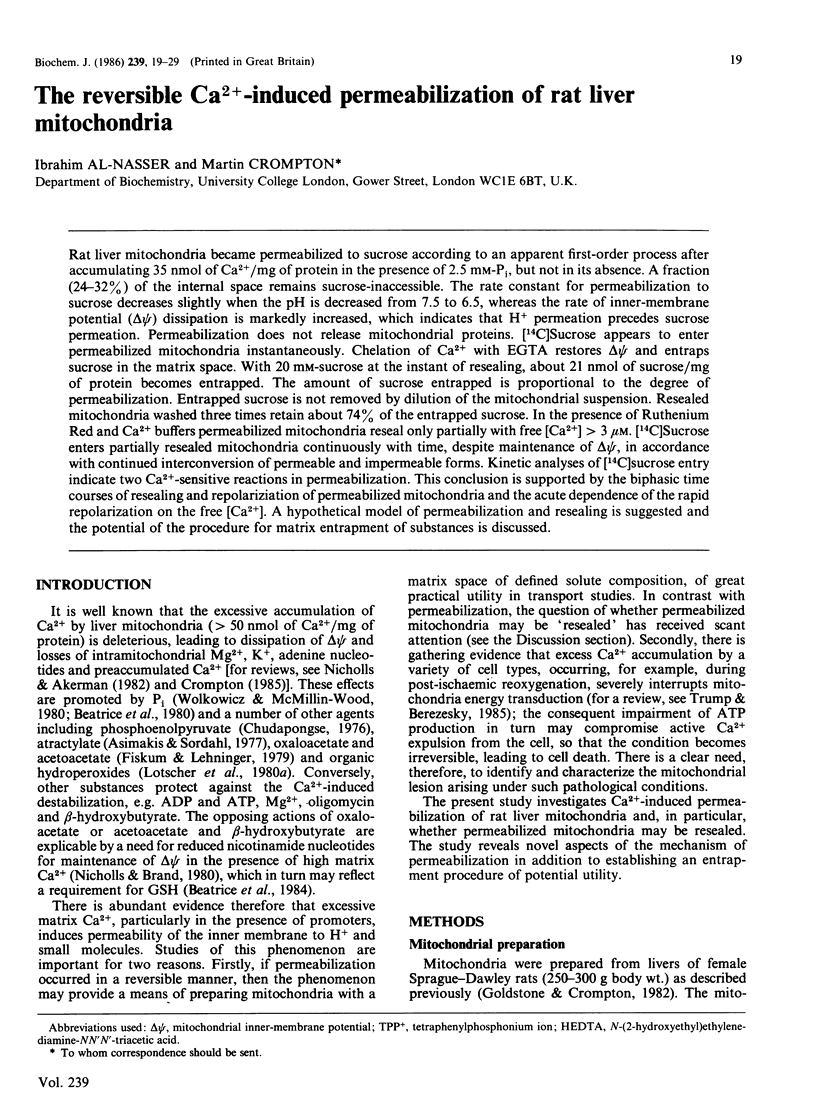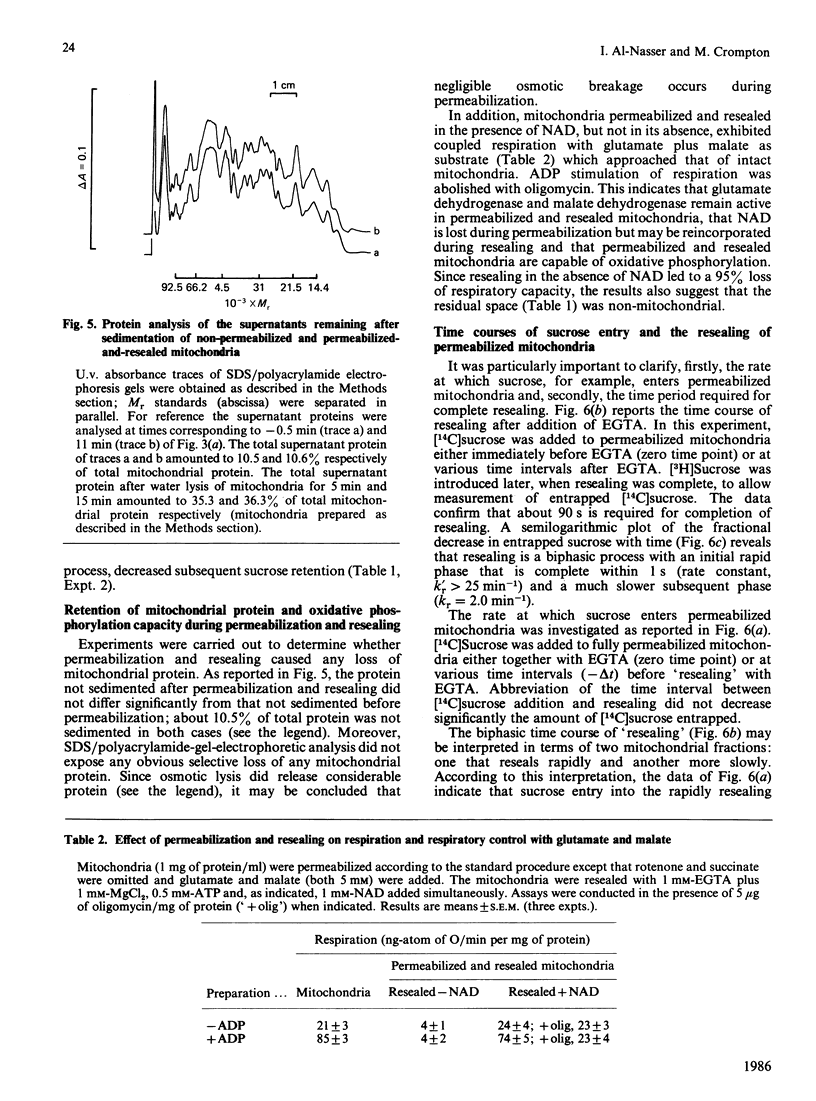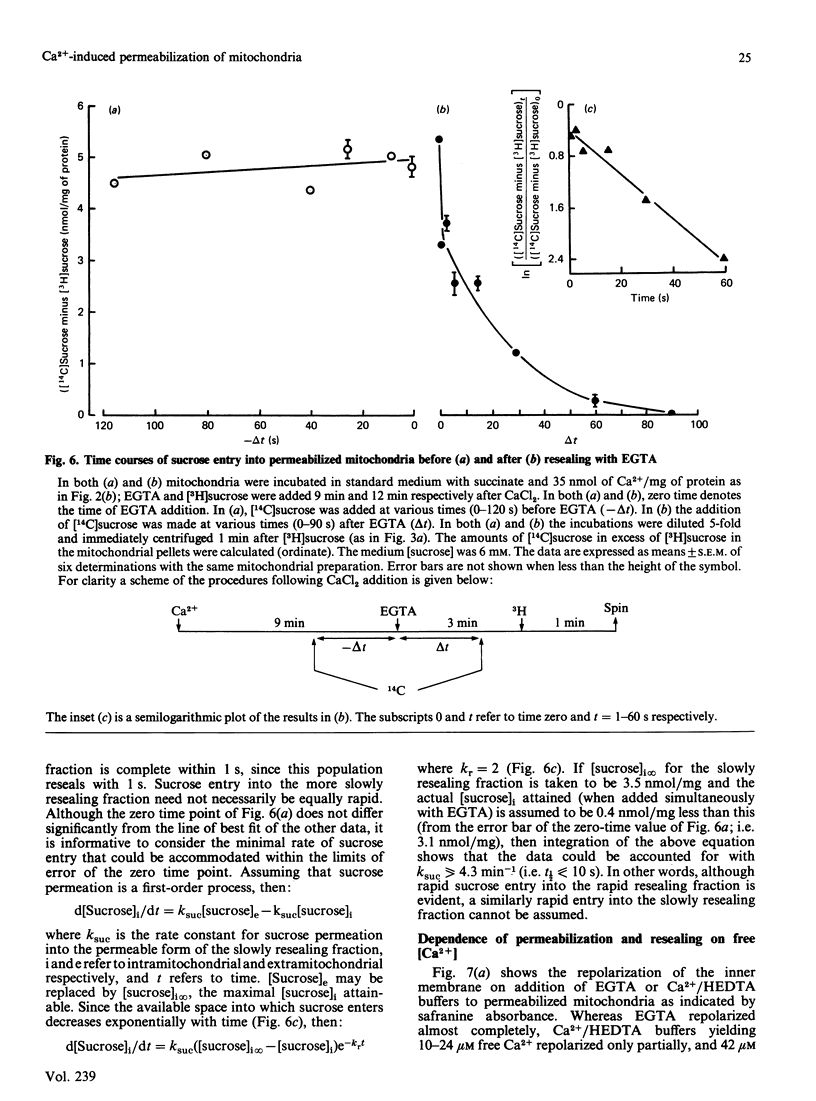Abstract
Rat liver mitochondria became permeabilized to sucrose according to an apparent first-order process after accumulating 35 nmol of Ca2+/mg of protein in the presence of 2.5 mM-Pi, but not in its absence. A fraction (24-32%) of the internal space remains sucrose-inaccessible. The rate constant for permeabilization to sucrose decreases slightly when the pH is decreased from 7.5 to 6.5, whereas the rate of inner-membrane potential (delta psi) dissipation is markedly increased, which indicates that H+ permeation precedes sucrose permeation. Permeabilization does not release mitochondrial proteins. [14C]Sucrose appears to enter permeabilized mitochondria instantaneously. Chelation of Ca2+ with EGTA restores delta psi and entraps sucrose in the matrix space. With 20 mM-sucrose at the instant of resealing, about 21 nmol of sucrose/mg of protein becomes entrapped. The amount of sucrose entrapped is proportional to the degree of permeabilization. Entrapped sucrose is not removed by dilution of the mitochondrial suspension. Resealed mitochondria washed three times retain about 74% of the entrapped sucrose. In the presence of Ruthenium Red and Ca2+ buffers permeabilized mitochondria reseal only partially with free [Ca2+] greater than 3 microM. [14C]Sucrose enters partially resealed mitochondria continuously with time, despite maintenance of delta psi, in accordance with continued interconversion of permeable and impermeable forms. Kinetic analyses of [14C]sucrose entry indicate two Ca2+-sensitive reactions in permeabilization. This conclusion is supported by the biphasic time courses of resealing and repolarization of permeabilized mitochondria and the acute dependence of the rapid repolarization on the free [Ca2+]. A hypothetical model of permeabilization and resealing is suggested and the potential of the procedure for matrix entrapment of substances is discussed.
Full text
PDF










Selected References
These references are in PubMed. This may not be the complete list of references from this article.
- Ackrell B. A., Kearney E. B., Singer T. P. Mammalian succinate dehydrogenase. Methods Enzymol. 1978;53:466–483. doi: 10.1016/s0076-6879(78)53050-4. [DOI] [PubMed] [Google Scholar]
- Akerman K. E., Wikström M. K. Safranine as a probe of the mitochondrial membrane potential. FEBS Lett. 1976 Oct 1;68(2):191–197. doi: 10.1016/0014-5793(76)80434-6. [DOI] [PubMed] [Google Scholar]
- Asimakis G. K., Sordahl L. A. Effects of atractyloside and palmitoyl coenzyme A on calcium transport in cardiac mitochondria. Arch Biochem Biophys. 1977 Feb;179(1):200–210. doi: 10.1016/0003-9861(77)90104-7. [DOI] [PubMed] [Google Scholar]
- Beatrice M. C., Palmer J. W., Pfeiffer D. R. The relationship between mitochondrial membrane permeability, membrane potential, and the retention of Ca2+ by mitochondria. J Biol Chem. 1980 Sep 25;255(18):8663–8671. [PubMed] [Google Scholar]
- Beatrice M. C., Stiers D. L., Pfeiffer D. R. Increased permeability of mitochondria during Ca2+ release induced by t-butyl hydroperoxide or oxalacetate. the effect of ruthenium red. J Biol Chem. 1982 Jun 25;257(12):7161–7171. [PubMed] [Google Scholar]
- Beatrice M. C., Stiers D. L., Pfeiffer D. R. The role of glutathione in the retention of Ca2+ by liver mitochondria. J Biol Chem. 1984 Jan 25;259(2):1279–1287. [PubMed] [Google Scholar]
- Broekemeier K. M., Schmid P. C., Schmid H. H., Pfeiffer D. R. Effects of phospholipase A2 inhibitors on ruthenium red-induced Ca2+ release from mitochondria. J Biol Chem. 1985 Jan 10;260(1):105–113. [PubMed] [Google Scholar]
- Chrambach A., Reisfeld R. A., Wyckoff M., Zaccari J. A procedure for rapid and sensitive staining of protein fractionated by polyacrylamide gel electrophoresis. Anal Biochem. 1967 Jul;20(1):150–154. doi: 10.1016/0003-2697(67)90272-2. [DOI] [PubMed] [Google Scholar]
- Chudapongse P. Further studies on the effect of phosphoenolpyruvate on respiration-dependent calcium transport by rat heart mitochondria. Biochim Biophys Acta. 1976 Feb 16;423(2):196–202. doi: 10.1016/0005-2728(76)90178-x. [DOI] [PubMed] [Google Scholar]
- Crompton M., Heid I. The cycling of calcium, sodium, and protons across the inner membrane of cardiac mitochondria. Eur J Biochem. 1978 Nov 15;91(2):599–608. doi: 10.1111/j.1432-1033.1978.tb12713.x. [DOI] [PubMed] [Google Scholar]
- Fiskum G., Lehninger A. L. Regulated release of Ca2+ from respiring mitochondria by Ca2+/2H+ antiport. J Biol Chem. 1979 Jul 25;254(14):6236–6239. [PubMed] [Google Scholar]
- Goldstone T. P., Crompton M. Evidence for beta-adrenergic activation of Na+-dependent efflux of Ca2+ from isolated liver mitochondria. Biochem J. 1982 Apr 15;204(1):369–371. doi: 10.1042/bj2040369. [DOI] [PMC free article] [PubMed] [Google Scholar]
- Goldstone T. P., Duddridge R. J., Crompton M. The activation of Na+-dependent efflux of Ca2+ from liver mitochondria by glucagon and beta-adrenergic agonists. Biochem J. 1983 Feb 15;210(2):463–472. doi: 10.1042/bj2100463. [DOI] [PMC free article] [PubMed] [Google Scholar]
- Hunter D. R., Haworth R. A., Southard J. H. Relationship between configuration, function, and permeability in calcium-treated mitochondria. J Biol Chem. 1976 Aug 25;251(16):5069–5077. [PubMed] [Google Scholar]
- Kamo N., Muratsugu M., Hongoh R., Kobatake Y. Membrane potential of mitochondria measured with an electrode sensitive to tetraphenyl phosphonium and relationship between proton electrochemical potential and phosphorylation potential in steady state. J Membr Biol. 1979 Aug;49(2):105–121. doi: 10.1007/BF01868720. [DOI] [PubMed] [Google Scholar]
- Kröger A., Klingenberg M. On the role of ubiquinone in mitochondria. II. Redox reactions of ubiquinone under the control of oxidative phosphorylation. Biochem Z. 1966 Jun 7;344(4):317–336. [PubMed] [Google Scholar]
- Lötscher H. R., Winterhalter K. H., Carafoli E., Richter C. Hydroperoxide-induced loss of pyridine nucleotides and release of calcium from rat liver mitochondria. J Biol Chem. 1980 Oct 10;255(19):9325–9330. [PubMed] [Google Scholar]
- Lötscher H. R., Winterhalter K. H., Carafoli E., Richter C. The energy-state of mitochondria during the transport of Ca2+. Eur J Biochem. 1980 Sep;110(1):211–216. doi: 10.1111/j.1432-1033.1980.tb04857.x. [DOI] [PubMed] [Google Scholar]
- Nicholls D. G., Brand M. D. The nature of the calcium ion efflux induced in rat liver mitochondria by the oxidation of endogenous nicotinamide nucleotides. Biochem J. 1980 Apr 15;188(1):113–118. doi: 10.1042/bj1880113. [DOI] [PMC free article] [PubMed] [Google Scholar]
- Nicholls D., Akerman K. Mitochondrial calcium transport. Biochim Biophys Acta. 1982 Sep 1;683(1):57–88. doi: 10.1016/0304-4173(82)90013-1. [DOI] [PubMed] [Google Scholar]
- Pfeiffer D. R., Schmid P. C., Beatrice M. C., Schmid H. H. Intramitochondrial phospholipase activity and the effects of Ca2+ plus N-ethylmaleimide on mitochondrial function. J Biol Chem. 1979 Nov 25;254(22):11485–11494. [PubMed] [Google Scholar]
- Rottenberg H. Membrane potential and surface potential in mitochondria: uptake and binding of lipophilic cations. J Membr Biol. 1984;81(2):127–138. doi: 10.1007/BF01868977. [DOI] [PubMed] [Google Scholar]
- Sitaramam V., Sarma M. K. Gravitational field enhances permeability of biological membranes to sucrose: an experimental refutation of sucrose-space hypothesis. Proc Natl Acad Sci U S A. 1981 Jun;78(6):3441–3445. doi: 10.1073/pnas.78.6.3441. [DOI] [PMC free article] [PubMed] [Google Scholar]
- Weber K., Osborn M. The reliability of molecular weight determinations by dodecyl sulfate-polyacrylamide gel electrophoresis. J Biol Chem. 1969 Aug 25;244(16):4406–4412. [PubMed] [Google Scholar]
- Wolkowicz P. E., McMillin-Wood J. Dissociation between mitochondria calcium ion release and pyridine nucleotide oxidation. J Biol Chem. 1980 Nov 10;255(21):10348–10353. [PubMed] [Google Scholar]


